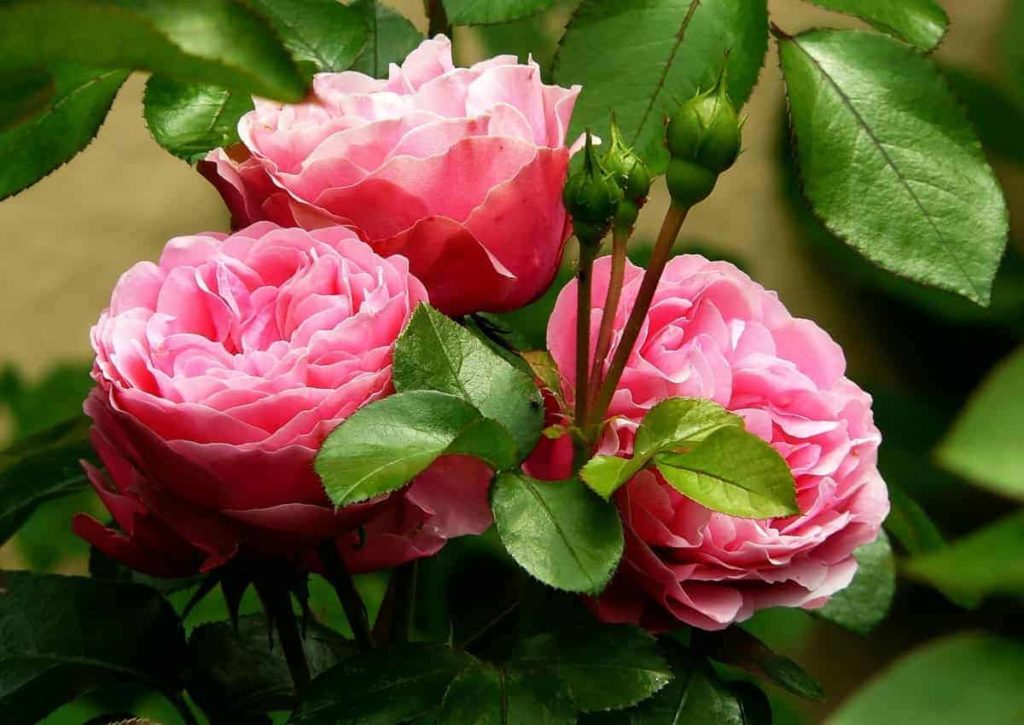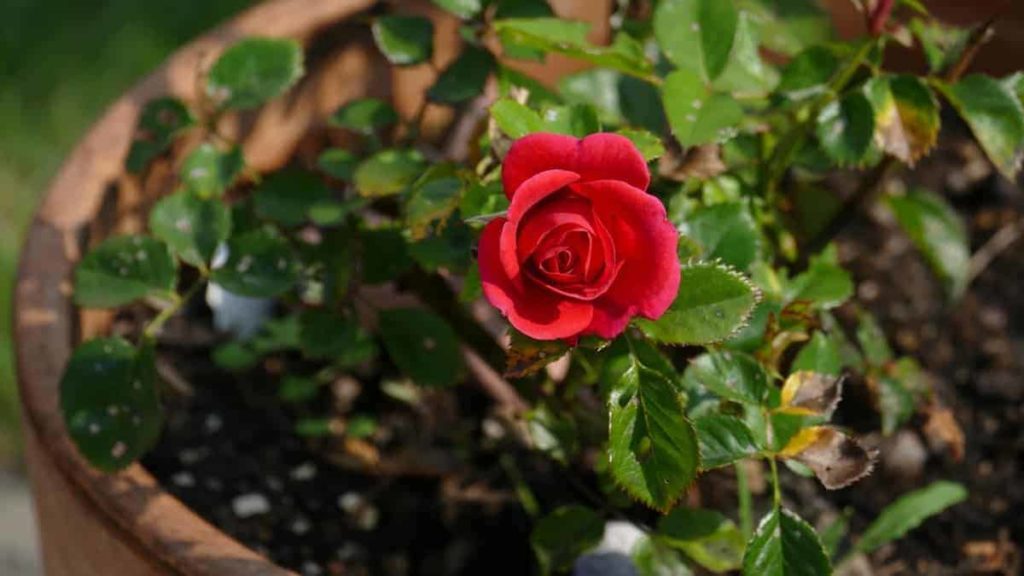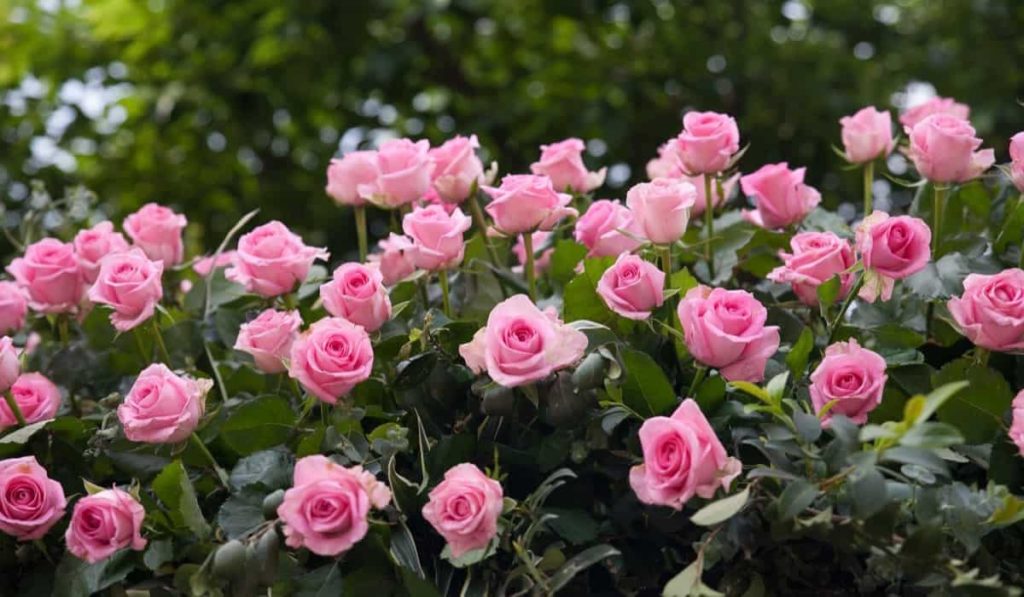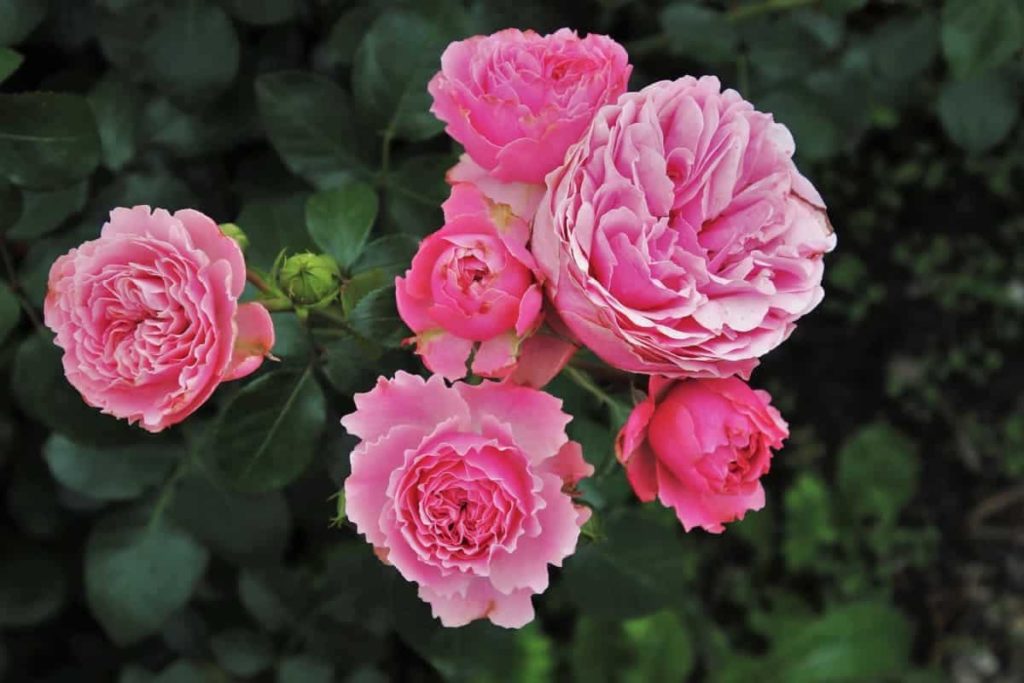The rose is one of the world’s most popular flowers. Everyone loves Roses, but some gardeners prefer not to cultivate them because of the belief that they need a lot of time and effort to maintain them. Roses were more challenging to cultivate 50 to 70 years ago when they were grown only for their flowers. Roses are now carefully selected to have a uniform appearance and are easy to cultivate in a garden. Let’s check out how to grow rose flowers at home in the USA.

Low-maintenance, disease-resistant, and easier-to-use varieties of shrub roses are very popular. In addition, shrub roses come in various sizes to match any setting. Many gardeners staying in the USA wonder how to grow rose plants in their homes. This article is a complete guide for such people. This article will discuss growing rose plants at home in the USA, in pots, backyard, and indoors.
How to grow rose flowers at home in the USA
Selecting and preparing the ideal location
To grow rose flowers at home in the US, they need at least six hours of sunlight a day to thrive. The drying effect of the light in the morning on the leaves is particularly significant in the fight against the disease. However, they may not die immediately, but roses planted in partial shade may weaken and produce weaker flowers and perform poorly over the winter months. In the northern United States, search for a location that gets full sun all year round.
Plants produce more flowers when they are exposed to more sunlight. If you’re in the southern part of the country, look for areas that get some midday shade. This shields flowers from the hot heat and helps your flowers endure longer. Consider planting roses near the foundation of your house if you live in a colder area of the USA. This gives plants some shelter from the cold throughout the winter. If the walkways are in full sunlight, they are also fantastic options. Avoid overcrowding your roses if you intend on using more than one.
Fungal infections like powdery and downy mildew can be prevented by good air circulation. They need soil that is both water-retentive and drainable so that the roots can absorb part of it. The failure to ensure appropriate drainage is one of the most serious errors. Roses are not fond of damp, icy feet. Roses want loose, sandy soil that isn’t too wet. The roots might get wet if there is too much clay in the soil.
If your soil isn’t already loose and loamy, you’ll have to conduct some amending before planting. Between 5.5 and 7.0, roses love somewhat acidic soil. However, according to most experts, a pH of 6.5 is ideal for most home gardens. You can find out your current pH level using a reliable soil test. Finely ground limestone is used to counteract acidic soil, whereas ground sulphur is used to cure alkaline soil.
How to grow roses in pots?
Select the pot for growing rose flowers
To grow rose flowers at home in the US in pots, a rose plant should be planted in a large and tall pot, but not too big or too little. A 15-inch-diameter pot is considered the minimum by many experts. The higher the container, the better for roses since they have deep roots.
Rose Planting Questions and Answers (FAQs)

When it comes to gardening, clay pots are preferable to plastic ones since the soil in pots warms up more quickly than in the garden. It is best to avoid using black plastic pots if at all possible. Lighter colored plastic will not heat up as quickly. Make sure the bottoms of the pots have plenty of drainage holes.
Soil preparation in pots
When you grow roses in a container, you must strike a careful balance. To prevent root rot, use a potting media that drains well yet is heavy enough to contain moisture. Fast-draining planting mediums will dry the roots out before they can absorb moisture, whereas rich organic soils will grow wet and fertile for rot.
One-third of commercial potting soil, one-third of composted manure, and one-third of garden compost should be used to mix the potting soil. First, improve drainage by sprinkling in a tablespoon of perlite. Then, adding a cup of bonemeal is all that is needed. Fishmeal can be added to the mix if desired, although over-fertilization might cause root burn.
Sunlight requirements in pots
Container roses need at least six hours of light each day to produce their finest flowers. However, too much sunlight can overheat the pot in hot weather or warmer climes and stress the roots.
Water and fertilizer requirements for rose plants in pots
Container roses need to be watered often since the soil dries up rapidly. The soil should be watered anytime the top inch of soil feels dry to the touch, and the soil should be saturated until water no longer comes out of the drainage holes. Even though the container is huge, daily watering may be required during the hot summer months.
Many nutrients are needed to keep roses blooming, and container roses will need more regular fertilization than those planted in the yard. When you plant your container roses, use a slow-release granular rose fertilizer and a little amount of bone meal to help the roots grow properly.
How to grow rose plants in the backyard?
Hole preparation in the backyard for rose plant
To grow rose flowers at home in the USA in the backyard, it’s best to dig a little larger but equally deep hole for the rose’s root ball to grow in. This is typically between 15 and 18 inches deep and 18 and 24 inches broad. Then, add some bone meal or superphosphate to the soil you’ve just removed and keep it for later use when you plant the roses in their new locations.
As a result, the rose bush will be better able to adapt to its new surroundings. Don’t give it anything else to eat while it’s just beginning. Before a lot of new development, the roots should be established. Adding some compost or other organic matter for poor-quality soil is excellent.
Preparing and planting the rose in the backyard in the US
The roots of your rose should be loosened somewhat if they come in a pot so they can begin to grow as soon as they are planted. You can generally get the plant out of the pot by holding the base and flipping the container. Make sure to check the roots if you’re planting a bare-root rose. Remove any rotted or damaged roots. To prevent the roots from drying out, immerse them in water for at least 12 hours before planting them.
For bare-root roses, use the removed soil and bone meal to create a mound in the center of the hole. As you build your mound, make sure the knobby graft union is barely visible when you set down your rose bush above it. If you’re planting roses in a container, make sure the graft union is below the soil surface. Depending on the variety, the graft union should be buried 1 to 2 inches into the soil surface when the plant has settled.
In case you missed it: Rose Plant Growing Tips, Ideas, Techniques, Secrets

Roses in containers should have their roots gently separated in the planting hole, and then the hole should be filled with soil. When the hole is about full, water the soil to help it settle, and gently pat the root zone with your hands as you finish filling up the hole so that it is packed.
Watering requirements for rose plants in the backyard
If you want to keep your roses flowering, you’ll need to provide them with a continuous water supply. The deeper you water them, the more likely their roots will grow deeper into the earth, where they will remain moist for a longer period. When watering your roses, use a soaker hose to keep the leaves dry and healthy.
Mulching requirements for rose plants
At least 3 to 4 inches should be left with weed-free pine needles, straw, or wood chips on the ground as a mulch. Keeping roses happy and healthy requires regular mulching.
Pest and disease management for rose flowers
Powdery mildew is most likely found at this time of the year, particularly if the weather is hot and dry, and damp at night. These include leaves that curl and twist and the appearance of white powdery down on the leaves. Therefore, water plants close to the ground in the morning since powdery mildew can’t grow where the leaves are dry. Additionally, cutting down on the rose bush’s leaves to allow for air circulation can assist in keeping this powdery growth at bay.
Waterborne fungi cause black spots. Leaf tops are covered in circular black or brown dots. It begins at the base of a shrub and works its way up, ultimately defoliating the whole plant. Powdery mildew can be avoided in the same manner that aphids can be prevented: increasing air circulation around and inside the plant and watering at ground level.
The spread of black spots can be slowed using a simple solution of baking soda and horticultural oil. An organic 3-in-1 fungicide is also an option. Aphids, Japanese beetles, spider mites, and sawflies are just a few pesky insects that prefer to feast on rose plants. Neem oil or insecticidal soap will take care of most of these pests. When dealing with aphids, a quick spray of water from a hose in the morning is usually sufficient. Aphids can also be prevented by planting alliums in close vicinity.
How to start rose plants from seeds?
To grow rose flowers at home in the USA from seeds, there is no need to manually pollinate flowers unless you breed certain plants together since insects and some types pollinate the flowers spontaneously. Therefore, please do not cut the rose flowers; instead, allow them to remain on the shrub. Rosehips, the little fruits that grow in their stead when they wither, will take their place.
The color of the rose hips will begin as green and gradually turn to red, orange, brown, or purple as they mature. You can pick them up or wait until they start to wrinkle and dry out at this stage. Then, using a knife, split the rose hips to expose the seeds inside. Using the point of a knife or any other tool, remove them. Each rosehip contains a different quantity of seeds depending on the kind of rose. Per rosehip, there might be a few or dozens.
In case you missed it: Homemade Fertilizers For Rose Plants – Manure, Compost

The pulp on the seeds can hinder them from germinating if it’s left on there. The pulp can be quickly removed by placing the seeds in a sieve or mesh and pouring water through it while rubbing the seeds against the edges. In addition, a water and hydrogen peroxide solution can slow mold development on seeds. Add 1.5 teaspoons of 3 percent hydrogen peroxide to 1 cup of water and mix well. This solution should be kept for at least an hour.
For rose seeds to germinate, they must be stored in a cool, moist environment similar to winter. A plastic bag or seedling tray can be used to preserve the seeds and wet material in a fridge at a low temperature. When seeds generally begin to germinate in the early spring, this is an excellent time to sow. Do not store food at temperatures lower than 70 degrees Fahrenheit. You can’t get the seeds to sprout until you remove them from the fridge. Germination can take anywhere from four weeks to sixteen weeks, depending on the rose type and the seed.
How to plant rose plants from stem/cuttings?
To grow rose flowers at home in the USA from cuttings, take a 12-inch section of a newly-blooming stem and cut it at a 45-degree angle from the plant. The length of the stem should be around the width of a pencil. The finest cuttings for roots frequently come from the edges of the bush rather than the core of the plant itself.
Only the two pairs of leaves at the very top of the stem should be left. Next, trim the stem slightly above the next leaves to remove the remaining part. To assist the cutting focus on root growth, remove the surplus leaves. Next, make a clean cut immediately below a stem node at the bottom of the stem using sharp pruning shears. A quarter-inch up from the stem’s base cut a diagonal slit across it.
Rooting hormone is not required in most cases, but it can help your rose plant grow new roots. You can buy rooting hormones in powder, liquid, or gel form, but the powder form works best with roses. Using a rose-specific potting mix, fill a tiny container with at least 6 inches of material.
Make a small hole in the potting material and insert the stem, sliced-side down, careful not to wipe off the rooting hormone—Water the stem after gently packing the soil around it. When roots begin to appear in approximately two weeks, keep the soil wet. Gently pull on the stem to see any roots present; if there is resistance, there are likely roots.
How to grow rose plants faster?
To grow rose plants faster, you need to fertilize them. For roses to bloom all summer long, they need three fertilizer applications. Two further applications in mid-June and mid-July will ensure that the flowers continue to flourish even after the plants emerge from their winter dormancy. In addition, roses can benefit from extra nutrients by using a well-balanced fertilizer and mulches such as compost or rotting manure. This will aid in the fast growth of the rose plant.
In case you missed it: Growing Rose Flowers in Greenhouse – A Full Guide

How to deadhead rose plants?
You can get your roses to bloom for as long as possible if you remove the spent flowers regularly. Taking away old flowers promotes the plant to produce more flowers than seeds since each leaf contains a growth bud. Every week or perhaps every day in the middle of summer is an excellent time to deadhead. Cut back the spent flower to the first leaf below it before deadheading. From this moment on, a new stem will emerge.
In addition to regularly deadheading, keep the beds spotless. Make sure the rose shrub is free of disease- and insect-carrying waste. Preferably by midseason, stop deadheading your rose bushes and wait for the plants to bear hips, which can then be plucked and dried in the shade and kept in an airtight container. To avoid encouraging new growth during a period when fresh shoots may be harmed by the cold, stop deadheading your rose bushes 3 to 4 weeks before the first heavy frost.
Overwintering for roses
You have to take care of the rose plant in winter since US winters are harsh. Roses should not be pruned throughout the autumn. Remove any dead or diseased canes by cutting them off. Prevent disease outbreaks by cleaning up the rose beds. It’s good to use a dormant spray to kill any remaining fungus. During winter drought, healthy plants stop feeding six weeks before the first autumn frost. In the meanwhile, keep the plants well-watered. Apply mulch or compost around the roses.
How to make the rose plant bushy?
Preparing rose plants before the 20-30 days of the flowering season by pruning and fertilizing, as well as giving them enough sunlight, watering when necessary, mulching, inspecting for pests, and pruning after the cut of flowers will help them grow bushier and produce more flowers if they are properly cared for.
In case you missed it: Growing Rose Plants On Terrace – In Pots, Containers

What is the best month to plant roses?
When planting roses, it is preferable to wait until after the last frost, or six weeks before your typical first frost, to do so. Planting in the fall allows the roots plenty of time to establish themselves before the plants enter their winter dormancy. Take care of all these parameters carefully while growing to increase the flowering in your rose plants. By following all the above instructions, you will be able to grow rose flowers at home in the USA.
- How to Grow Hibiscus from Flower
- Plantation Ideas for Home Decoration: A Beginners Guide
- Flower Garden Designs and Layouts for Beginners
- Planting and Spacing Techniques in Papaya: A Beginner’s Guide
- Growing Gold: Essential Techniques for Planting Pineapples
- How to Make Kalanchoe Plant Bushy: Home Remedies and Solutions
- 11 Reasons Why Your Gardenia is Not Blooming: Home Remedies and Solutions
- Eco Elegance: The Guide to Designing a Drought-Tolerant Landscape
- Gardening on a Slope: Strategies for Hillside Landscaping
- Nourish and Flourish: Top Organic Mulches for Thriving House Plants
- Everything You Want to Know about Indian Mogra Flower: Discover Uses and Growing
- Green Thumb Success: Expert Tips for Cultivating Greenhouse Pumpkins All Year Round
- Maximize Growth & Flavor: The Ultimate Guide to Companion Planting in Herb Gardens
- How to Control Rhododendron Problems Naturally: Home Remedies and Organic Ways to Fix Them
- Natural Magic: The Remarkable Benefits of Cinnamon for Plants
- Best Steps to Revive Dying Tulip with Natural and Organic Treatment
- 10 Reasons Why Your Angel Trumpet is Not Blooming: Remedies and Treatment
- How to Fix Periwinkle Leaf and Flower-Related Problems: Natural Remedies and Solutions
- How to Fix Zinnias Leaf and Flower Problems: Discover Natural and Home Remedies
- Organic Steps to Induce Lemon Tree Flowers: A Comprehensive Guide
- Bloom Booster: Crafting the Perfect Homemade Bougainvillea Fertilizer
- Optimizing Growth: A Guide to Applying NPK Fertilizer for Potted Plants
- 10 Best Homemade Fertilizers for Rubber Plant: DIY Recipes and Application Method
- How to Boost Female Pumpkin Flowers: Effective Steps for More Flowers and High Yields
- Transform Your Indoor Garden: Top Benefits of Pink Salt for Houseplants
- 10 Best Homemade Fertilizers for Peacock Plants (Calathea): Easy DIY Guide
- Unlock Blooms: 9 Reasons Why Your Potted Chrysanthemum is Not Blooming
- 8 Reasons Why Your Potted Hibiscus is Not Blooming: Fix it with Simple Solutions
- Unlock Blooms: 9 Key Reasons Your Potted Frangipani Won’t Flower
- 10 Reasons Why Is My Ice Plant Not Blooming: Remedies and Treatment
- 10 Reasons Why My Potted Hydrangea Not Blooming: Treatment and Remedies
- 10 Reasons Why is My Wisteria Not Blooming: Remedies and Treatment
- 10 Reasons Why is My Goldfish Plant Not Blooming: Remedies and Treatment
- Maximize Your Space: Ultimate Guide to Balcony Gardening with Grow Bags
- 10 Reasons Why Your Iris is Not Blooming: Remedies and Treatment
- 10 Reasons Why Your Anthurium Plant is Not Blooming: Treatment and Remedies